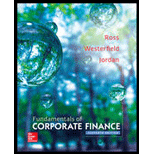
a)
To determine: Whether the dollar is sold at a discount that is relative to a franc or at a premium.
Introduction:
The price of a country’s currency in relative to the of another nation’s currency is the exchange rate. The rate of exchange can be either floating or fixed. The two components of the exchange rates are the foreign currency and the domestic currency.
b)
To determine: Whether the financial market expect the value of franc to strengthen comparatively to the value of a dollar.
Introduction:
The market where the people trade the securities and commodities is a financial market. The main function of the financial market is to borrow and lend.
c)
To determine: The true suspect of the relative economic conditions in Country U and in Country S
Introduction:
The present state of the economy in a region or a country is the economic conditions.
Want to see the full answer?
Check out a sample textbook solution
Chapter 21 Solutions
Fundamentals of Corporate Finance
- Ends Mar 30 Discuss in detail what is Free Cash Flows and how is it calculated. Also define what is a Sunk Cost as well as an Opportunity Cost. 0arrow_forwardSubscribe Explain in detail what is a firm's Capital Structure? What is and how does a firm's Financial Policy impact its Capital Structure? Finally, what is opportunity costs and how does it affect a firm's Capital Structure?arrow_forwardWhat is the answer of this finance wuarrow_forward
 Managerial Accounting: The Cornerstone of Busines...AccountingISBN:9781337115773Author:Maryanne M. Mowen, Don R. Hansen, Dan L. HeitgerPublisher:Cengage Learning
Managerial Accounting: The Cornerstone of Busines...AccountingISBN:9781337115773Author:Maryanne M. Mowen, Don R. Hansen, Dan L. HeitgerPublisher:Cengage Learning Intermediate Financial Management (MindTap Course...FinanceISBN:9781337395083Author:Eugene F. Brigham, Phillip R. DavesPublisher:Cengage Learning
Intermediate Financial Management (MindTap Course...FinanceISBN:9781337395083Author:Eugene F. Brigham, Phillip R. DavesPublisher:Cengage Learning


